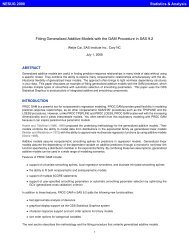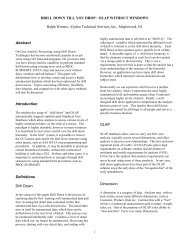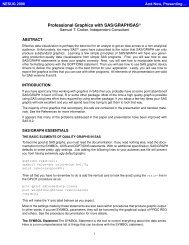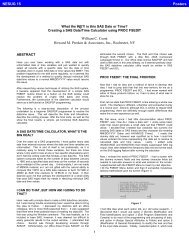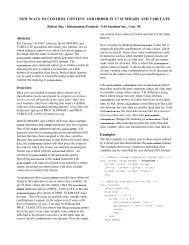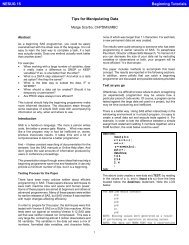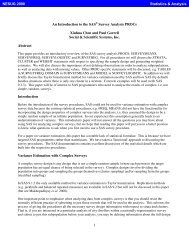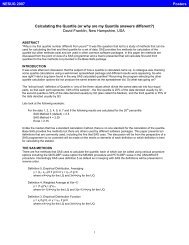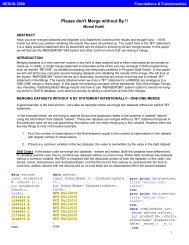List Processing Basics: Creating and Using Lists of Macro ... - NESUG
List Processing Basics: Creating and Using Lists of Macro ... - NESUG
List Processing Basics: Creating and Using Lists of Macro ... - NESUG
You also want an ePaper? Increase the reach of your titles
YUMPU automatically turns print PDFs into web optimized ePapers that Google loves.
<strong>NESUG</strong> 2007H<strong>and</strong>s-On WorkshopsCONVERT TO MACROFinally change the allocation <strong>of</strong> the macro variablefrom %Let to %macro parameter. 1 %macro Report( Region=Africa);2 ... file = "&Region..html"3 Title "Sales in &Region.";4 where Region = "&Region.";The next task is to identify the list <strong>of</strong> parametervalues <strong>and</strong> decide how best togenerate the macro calls shown here inthe test section at the bottom <strong>of</strong> the program.Note lines 5–9: Since one value containsa slash (/) we create a newvariable Filename <strong>and</strong> change theslash to a hyphen to avoid an operatingsystem clash <strong>of</strong> folder CentralAmerica/Caribbean not existing.Task: How to generate these macro calls?Report-Region-macro.sas28 %Report(Region = Africa);29 %Report(Region = Asia );30 %Report(Region31 = Central America/Caribbean);See Ex00, pg. 16.To speed up our testing, we write a verysimple test macro which only lists its parametervalues.Report-Region-macro.sas1 %<strong>Macro</strong> Report(InData = sashelp.Shoes2 ,Region =3 ,OutPath = /*here: same folder*/4 );5 %local Filename; %Let Filename = &Region.;6 %** change slash to hypen in7 Central America/Caribbean;8 %If %index(&Region,/) %then %Let Filename =9 %sysfunc(translate(&Region.,-,/));1011 ods html file = "&OutPath.&Filename..html"12 style = journal;1314 Title "Sales in &Region.";1516 PROC Report data = &InData.17 nowindows;18 where Region = "&Region.";19 column Product Subsidiary, Sales;20 define Product / group;21 define Subsidiary / across;22 define Sales / analysis ’’;23 run;24 ods html close;25 run; %mend Report;ReportTest.sas1 %<strong>Macro</strong> ReportTest(Region = );2 %put _local_;3 run; %Mend;MAKING LISTSWHAT IS A LIST?In conversation we use the word list to mean any collection <strong>of</strong> items,however they may be related. An example would be a todo or shoppinglist. The items in the list share a common property: tasks to bedone, items to purchase. In a formal language, such as set theory,a list is defined as an unordered set. In the SAS language a list isa table. For our discussion here, the list is a collection <strong>of</strong> the uniquevalues <strong>of</strong> the variable region <strong>of</strong> the table sashelp.shoes.Definition <strong>of</strong> <strong>List</strong>1. natural language: list contains items2. formal language: an unordered set3. SAS: data set or tableWHERE ARE LISTS?SAS provides many unique data sets in either sashelp views or sqldictionary tables. DiIorio <strong>and</strong> Abolafia [5, sugi29.237] provide a comparision<strong>of</strong> sashelp views <strong>and</strong> sql dictionary tables <strong>and</strong> a dozen examples.Most summarization procedures — freq <strong>and</strong> means/summary— can produce an output data set which contains a unique list <strong>of</strong> variablevalues. Fehd [8, pnwsug2006.012] provides usage examples <strong>of</strong>the more common sql dictionary tables.Sources <strong>of</strong> <strong>List</strong>s1. sashelp views2. sql dictionary tables3. summarization procedure output3



